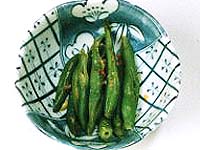|
SAKE & FOOD
Top Page 
Recipes
Kasu Dishes
Etiquette
Sake Vessels
Food & Flavor
50+ sake pubs and restaurants in Tokyo; searchable by ward.
Click here for a complete guide to Japanese cuisine, with recipes, culinary travel tips, sake listings and more.
|
|
|
|
 Pairing Food and Sake Pairing Food and Sake
Matching food and sake is just like matching food and wine. It's a fun,
imprecise process that depends, in the end, on your own taste preferences. What is a match made in heaven for one person may seem a mismatch to another. The important thing is how the pairing feels and
tastes to you.
From this point of view, there is no unequivocal answer to the question "what food goes best with sake (or wine)." Neverthelss, there are still
some basic tips that can help you make the most of your pairing experience.
- Some foods just don't work well with sake (i.e., very spicy food and strong-flavored dishes).
- Cooking with sake opens up a whole new realm of flavor sensations. Most recipes that call for wine in the cooking
process could use sake instead.
- The quality of the sake you use in cooking does matter. Use a ginjo (see Types of Sake) with flavor-sensitive, delicate foods like
fresh seafood. With heartier foods, such as pork, you can use even a slightly stale sake without unpleasant results.
- Sake is complex. It presents slightly different faces at slightly different temperatures, and there is no one correct temperature to
drink it. Different taste aspects of a sake will present themselves in different situations. Experiment.
- Food is likewise complex. The same dish will seem different depending on who prepares it, and a slight difference in the
spices or methods of preparation used will make all the difference in the world. It is not possible to unequivocally say that a particular dish goes well with a given sake.
- Have fun. Pairing sake and food should be fun, precisely because it is an imprecise process. The object of the game is to enhance
both the food and the sake. No match is perfect, and in the end, it is a matter of what you like.
- Dont' limit your pairing to Japanese or Asian food. There is truly a vast array of possibilities for sake. Give your own local cuisine
a chance.
 Some Basic Pairing Strategies Some Basic Pairing Strategies
There are basically two ways to pair a sake with food, and they are
similar to how wine and food are paired. Either match a sake with a dish that has similar or complementary flavors or characteristics, or pair
the sake and food for their contrast. The first step is to determine which half of the equation you will begin with: do you have a sake you need to
create a meal around, or do you need a sake to match the meal you've chosen?
What do you look for in a sake when agonizing over such decisions?
Fragrance, for one. A very fruity nose may complement a rich morsel but clash with a more herbal baked dish. How sweet or dry is a sake,
what is the acidity like, how full is the flavor? These are the aspects of a sake you want to match or contrast. The Tasting Charts used at eSake
.com are an excellent way to see at a glance whether a sake can offer you the characteristics you are looking for. See example chart below.
- For example, a slightly sweet sake brewed with soft water like sake from Hiroshima might go well with a cream-based dish,
better than a bone-dry and clean sake.
- A sake with a good acidity to it, like a classic junmai-shu, often goes well with something like tempura, as it stands up to the oily
nature of the dish quite well.
- Sake with a decent bitter tone or earthiness to it will often side right up to vegetable dishes, coaxing out the same aspects in
some of the more bitter leafy greens.
- Premium sake that is complex and layered (e.g., like ginjo or daiginjo sake) generally don't work well with a protein-rich meal.
- Some sake has a grainy mouth feel that is often more distinctive and defining than the flavors involved. Sake like this would work
better with a vegetable dish than with a light, creamy dish. The textures become the common denominator.
 In the end, tasting charts and written descriptions will only go so far. You need to taste sake to be able to grasp what charts and words really are trying to reveal. In the end, tasting charts and written descriptions will only go so far. You need to taste sake to be able to grasp what charts and words really are trying to reveal.
Below is an example of an eSake Flavor Chart. For more charts, those covering all the main types/grades of sake, please visit the Sake Knowledge section, Types of Sake page.
|
|
|
|